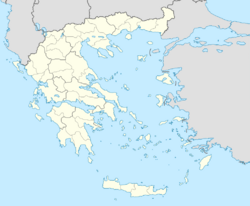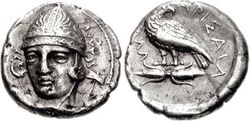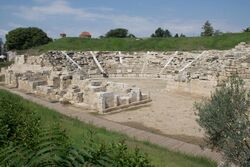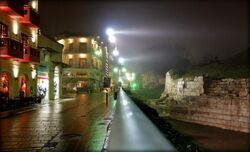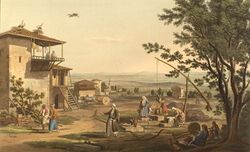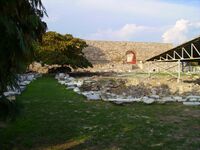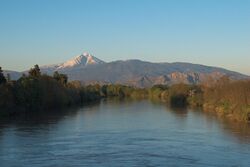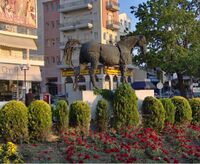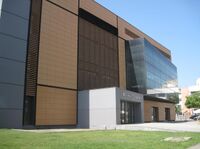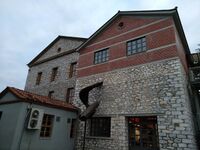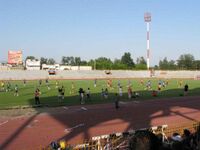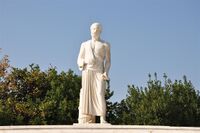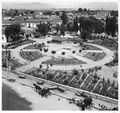Larissa
Topic: Place
 From HandWiki - Reading time: 18 min
From HandWiki - Reading time: 18 min
Larissa Λάρισα (Greek) | |
|---|---|
Municipality | |
| Δήμος Λαρισαίων | |
Error: No valid link was found at the end of line 5. Clockwise from top left: Central Square in downtown Larissa with the "Floating River" fountain; Municipal Theatre OUHL (Thessalian Theatre); Holocaust monument; Saint Achilles Cathedral; Old Mills of Pappas; Larissa railway station; and the First Ancient Theatre of Larissa | |
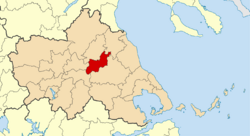 | |
| Coordinates: [ ⚑ ] : 39°38.5′N 22°25′E / 39.6417°N 22.417°E | |
| Country | |
| Regional unit | Larissa |
| Government | |
| • Type | Mayor–council government |
| • Mayor | Athanasios Mamakos[2] |
| Area | |
| • Total | 122.59 km2 (47.33 sq mi) |
| Elevation | 67 m (220 ft) |
| Population (2021)(2021) [3] | |
| • Total | 148,562(city proper)[1] 164,381(municipality) |
| Demonym(s) | Larissean |
| Time zone | UTC+2 (EET) |
| • Summer (DST) | UTC+3 (EEST) |
| Area code(s) | 0030 241 |
| Website | www.larissa-dimos.gr |
| Click on the map for a fullscreen view | |
Larissa (/ləˈrɪsə/; Greek: Λάρισα, Lárisa, pronounced [ˈlarisa] (![]() listen)) is the capital and largest city of the Thessaly region in Greece. It is the fifth-most populous city in Greece with a population of 148,562 in the city proper, according to the 2021 census.[1] It is also capital of the Larissa regional unit. It is a principal agricultural centre and a national transport hub, linked by road and rail with the port of Volos, the cities of Thessaloniki and Athens. The municipality of Larissa has 164,381 inhabitants, while the regional unit of Larissa reached a population of 269,151 ((As of 2021)).[3]
listen)) is the capital and largest city of the Thessaly region in Greece. It is the fifth-most populous city in Greece with a population of 148,562 in the city proper, according to the 2021 census.[1] It is also capital of the Larissa regional unit. It is a principal agricultural centre and a national transport hub, linked by road and rail with the port of Volos, the cities of Thessaloniki and Athens. The municipality of Larissa has 164,381 inhabitants, while the regional unit of Larissa reached a population of 269,151 ((As of 2021)).[3]
Legend has it that Achilles was born here. Hippocrates, the "Father of Medicine", died here. Today, Larissa is an important commercial, transportation, educational, agricultural and industrial centre of Greece. The city straddles the Pineios river and N.-NE. of the city are the Mount Olympus and Mount Kissavos.
Mythology
According to Greek mythology it is said that the city was founded by Acrisius, who was killed accidentally by his grandson, Perseus.[4] There lived Peleus, the hero beloved by the gods, and his son Achilles.
In mythology, the nymph Larissa was a daughter of the primordial man Pelasgus.[5]
The city of Larissa is mentioned in Book II of Iliad by Homer: "Hippothous led the tribes of Pelasgian spearsmen, who dwelt in fertile Larissa- Hippothous, and Pylaeus of the race of Mars, two sons of the Pelasgian Lethus, son of Teutamus."[6][7] In this paragraph, Homer shows that the Pelasgians, Trojan allies, used to live in the city of Larissa. It is likely that this city of Larissa was different to the city that was the birthplace of Achilles. The Larissa that features as a Trojan ally in the Iliad was likely to be located in the Troad, on the other side of the Aegean Sea.
History
Antiquity
Pre-history
Traces of Paleolithic human settlement have been recovered from the area, but it was peripheral to areas of advanced culture.[8] The area around Larissa was extremely fruitful; it was agriculturally important and in antiquity was known for its horses.
Archaic Era
The name Larissa (Λάρισα Lárīsa) is in origin a Pelasgian word for "fortress".[citation needed] There were many ancient Greek cities with this name.[9] The name of Thessalian Larissa is first recorded in connection with the aristocratic Aleuadai family.[10] It was also a polis (city-state).[11]
Classical Era
Larissa was a polis (city-state) during the Classical Era.[12] Larissa is thought to be where the famous Greek physician Hippocrates and the famous philosopher Gorgias of Leontini died.
When Larissa ceased minting the federal coins it shared with other Thessalian towns and adopted its own coinage in the late fifth century BC, it chose local types for its coins. The obverse depicted the nymph of the local spring, Larissa, for whom the town was named; probably the choice was inspired by the famous coins of Kimon depicting the Syracusan nymph Arethusa. The reverse depicted a horse in various poses. The horse was an appropriate symbol of Thessaly, a land of plains, which was well known for its horses. Usually there is a male figure; he should perhaps be seen as the eponymous hero of the Thessalians, Thessalos, who is probably also to be identified on many of the earlier, federal coins of Thessaly.
Larissa, sometimes written Larisa on ancient coins and inscriptions, is near the site of the Homeric Argissa. It appears in early times, when Thessaly was mainly governed by a few aristocratic families, as an important city under the rule of the Aleuadae, whose authority extended over the whole district of Pelasgiotis. This powerful family possessed for many generations before 369 BC the privilege of furnishing the tagus, the local term for the strategos of the combined Thessalian forces. The principal rivals of the Aleuadae were the Scopadae of Crannon, the remains of which are about 14 miles south west.
Larissa was the birthplace of Meno, who thus became, along with Xenophon and a few others, one of the generals leading several thousands Greeks from various places, in the ill-fated expedition of 401 (retold in Xenophon's Anabasis) meant to help Cyrus the Younger, son of Darius II, king of Persia, overthrow his elder brother Artaxerxes II and take over the throne of Persia (Meno is featured in Plato's dialogue bearing his name, in which Socrates uses the example of "the way to Larissa" to help explain Meno the difference between true opinion and science (Meno, 97a–c); this "way to Larissa" might well be on the part of Socrates an attempt to call to Meno's mind a "way home", understood as the way toward one's true and "eternal" home reached only at death, that each man is supposed to seek in his life).[13]
The constitution of the town was democratic, which explains why it sided with Athens in the Peloponnesian War. In the neighbourhood of Larissa was celebrated a festival which recalled the Roman Saturnalia, and at which the slaves were waited on by their masters. As the chief city of ancient Thessaly, Larissa was taken by the Thebans and later directly annexed by Philip II of Macedon in 344. It remained under Macedonian control afterwards, except for a brief period when Demetrius Poliorcetes captured it in 302 BC.
Hellenistic Era
Roman Era
It was in Larissa that Philip V of Macedon signed in 197 BC a treaty with the Romans after his defeat at the Battle of Cynoscephalae, and it was there also that Antiochus III the Great, won a great victory in 192 BC. In 196 BC Larissa became an ally of Rome and was the headquarters of the Thessalian League.
Larissa is frequently mentioned in connection with the Roman civil wars which preceded the establishment of the Roman Empire and Pompey sought refuge there after the defeat of Pharsalus.
Middle Ages
Larissa was sacked by the Ostrogoths in the late 5th century, and rebuilt under the Byzantine emperor Justinian I.[14]
In the eighth century, the city became the metropolis of the theme of Hellas.[14] The city was captured in 986 by Tsar Samuel of Bulgaria, who carried off the relics of its patron saint, Saint Achilleios, to Prespa.[14] It was again unsuccessfully besieged by the Italo-Normans under Bohemond I in 1082/3.[14]
After the Fourth Crusade, the King of Thessalonica, Boniface of Montferrat, gave the city to Lombard barons, but they launched a rebellion in 1209 that had to be subdued by the Latin Emperor Henry of Flanders himself.[14] The city was recovered by Epirus soon after.[14]
Ottoman period
Larissa was conquered by the Ottoman Empire in 1386/87 and again in the 1390s, but only came under permanent Ottoman control in 1423, by Turahan Bey.[15] Under Ottoman rule, the city was known as Yeni-şehir i-Fenari, "new citadel". As the chief town and military base of Ottoman Thessaly, Larissa was a predominantly Muslim city.[15] In 1521 (Hijri 927) the town had 693 Muslim and 75 Christian households;[16] according to Gökbilgin (1956), it also included Albanian and Jewish communities.[17] During Ottoman rule the administration of the Metropolis of Larissa was transferred to nearby Trikala where it remained until 1734, when Metropolitan Iakovos II returned the see from Trikala to Larissa and established the present-day metropolis of Larissa and Tyrnavos.
The town was noted for its trade fair in the 17th and 18th centuries, while the seat of the pasha of Thessaly was also transferred there in 1770.[15] Larissa was the headquarters of Hursid Pasha during the Greek War of Independence. It was also renowned for its mosques (four of which were still in use in the late 19th century) and its muslim cemeteries.[citation needed]
The city remained a part of the Ottoman Empire until Thessaly became part of the independent Kingdom of Greece in 1881, except for a period where Ottoman forces re-occupied it during the Greco-Turkish War of 1897.[15] In the late 19th century, there was still a small village in the outskirts of the town inhabited by Africans from Sudan, a curious remnant of the forces collected by Ali Pasha.
In the 19th century, the town produced leather, cotton, silk and tobacco. Fevers and agues were prevalent owing to bad drainage and the overflowing of the river; and the death rate was higher than the birth rate.[dubious ]
Modern Greek era
In 1881, the city, along with the rest of Thessaly, was incorporated into the Kingdom of Greece during the prime ministry of Alexandros Koumoundouros. On 31 August 1881 a unit of the Greek Army headed by General Skarlatos Soutsos entered the city. A considerable portion of the Turkish population emigrated into the Ottoman Empire at that point. In this new era the city starts gradually to expand and to be rebuilt by the Greek authorities.
During the Greco-Turkish War of 1897, the city was the headquarters of Greek Crown Prince Constantine. The flight of the Greek army from here to Farsala took place on April 23, 1897. Turkish troops entered the city two days later. After a treaty for peace was signed, they withdrew and Larissa remained permanently in Greece. This was followed by a further exodus of Turks in 1898. The Hassan Bey mosque (which was built in the early 16th century) was demolished in 1908.
During the Axis Occupation of the country, the Jewish community of the city (dated back to second BC, see Romaniotes) suffered heavy losses. Today in the city there is a Holocaust memorial and a synagogue.
After WWII
After WWII the city was expanded rapidly. Today Larissa is the fourth largest Greek city with many squares, taverns and cafes. It has three public hospitals with one being a military hospital. It hosts the Hellenic Air Force Headquarters and NATO Headquarters in Greece. It has a School of Medicine and a School of Biochemistry – Biotechnology and the third largest in the country Institute of Technology. It occupies the first place among Greek cities into green coverage rate per square-metre urban space and the first place with the highest percentance of bars-taverns-restaurants per capita in Greece. It also has two public libraries and five museums.[18]
Ecclesiastical history
Christianity penetrated early to Larissa, though its first bishop is recorded only in 325 at the Council of Nicaea. St. Achillius of the fourth century, is celebrated for his miracles. Le Quien cites twenty-nine bishops from the fourth to the 18th centuries;[19] the most famous is Jeremias II, who occupied the see until 733, when the Emperor Leo III the Isaurian transferred it from the jurisdiction of the Pope of Rome to the Patriarchate of Constantinople. In the first years of the tenth century it had ten suffragan sees;[20] subsequently the number increased and about the year 1175 under the Emperor Manuel I Comnenus, it reached twenty-eight.[21] At the close of the 15th century, under the Ottoman domination, there were only ten suffragan sees,[22] which gradually grew less and finally disappeared.

Larissa is an Orthodox Metropolis of the Church of Greece.
It was also briefly a Latin archbishopric in the early 13th century, and remains a Latin Metropolitan (top-ranking) titular see of the Roman Catholic Church, which must not be confused with the Latin episcopal (low-ranking) titular see Larissa in Syria. Today there is a Catholic church in the city (Sacred Heart of Jesus).
Sights
In the area from the Frourio hill to the Central square is located the old part of the city where some of its main landmarks are. Sights of the city are:
- The Frourio Hill and the adjacent First Ancient Greek Theatre area.
- The Pineios river that crosses the city center near the St. Achillios church and the Alkazar Park next to the lush river banks of Pineios river.
- The First Ancient Greek Theatre of Larissa, built in the 3rd c. BC.
- The Second Ancient Theatre, built in the 1st c. BC.
- The Basilica of St. Achillios. Early Byzantine basilica ruins dedicated to the city's patron saint, St. Achillios.
- The church of St. Achillios Cathedral.
- The Bezesten of Larissa. Built in the 15th c. was an ottoman enclosed market and also used in the 19th c. as a gunpowder magazine and fort.
- The Yeni Mosque, a rare example of 19th c. mosque built in neoclassical style, now used as a museum.
- The Ottoman Baths probably built in the 15th c.
- The Cenotaph monument of Hippocrates, the 4th c. B.C. votive stele dedicated to Poseidon and many other ancient ruins and monuments.
- The Diachronic Museum of Larissa with finds that cover all history of Larissa since antiquity.
- Historical buildings that have been listed as architecturally preserved, such as the Mill of Pappas, the Cine Palace (architect Colonello), the Charokopos Tower (arch. Anastasios Metaxas, buit in 1902, endangered to collapse as of 2022) and the neoclassical complex of the Averofeios Agricultural School (built in 1908).
Geography
Larissa is around 120 kilometres (75 mi) south-west of Thessaloniki and around 210 kilometres (130 mi) north-west of Athens.
There are a number of highways including E75 and the main railway from Athens to Thessaloniki (Salonika) crossing through Thessaly. The region is directly linked to the rest of Europe through the International Airport of Central Greece located in Nea Anchialos a short distance from Larissa (about 60 km [37 mi]). Larissa lies on the river Pineios.
The municipality of Larissa has an area of 335.98 km2 (129.72 sq mi), the municipal unit Larissa has an area of 122.586 km2 (47.331 sq mi), and the community Larissa has an area of 88.167 km2 (34.041 sq mi).[23]
The city is in close proximity of destinations such as Mount Olympus, Mount Kissavos, Meteora, Lake Plastira, Pilio, etc.
The Larissa Chasma, a deep gash in the surface of Dione, a natural satellite of Saturn, was named after Larissa.
Climate
The climate of Larissa is cold semi-arid (Köppen: BSk) with some Mediterranean climate (Csa) characteristics such as the drier summers and the somewhat wetter winters.[24] The winter is cold, and some snowfalls may occur, though few of them are heavy. The summer is particularly hot, and temperatures near or above 40 °C (104 °F) typically occur every year for a few days. Thunderstorms during the summer months are sometimes heavy and may cause agricultural damage. Larissa receives about 413 mm (16 in) of rain per year and has an average annual average temperature of 15.4 °C (59.7 °F).[25]
Script error: No such module "weather box".
Script error: No such module "weather box".
Administration
The municipality Larissa was formed at the 2011 local government reform by the merger of the following 3 former municipalities, that became municipal units:[28]
- Giannouli
- Koilada
- Larissa
Districts
The municipal unit of Larissa is divided into four city-districts or municipal communities (29 city areas) plus 2 suburban communities (Amphithea and Koulourion). The municipality includes also the Community of Terpsithèa (with the suburban community of Argyssa).
1st Municipal District
(pop. 26,035)
- Papastàvrou
- Saint Athanàsios
- Alkazàr
- Hippocrates-Pèra
- Potamòpolis
- Philippòpolis
- Livadàki
- Saint Thomas
- Saint Paraskevi-Mezourlo
- Neàpolis
2nd Municipal District (pop. 41,816)
- Saint Achellios
- Saint Nikòlaos
- Ambelòkipoi
- Saints Sarànta
- Saint Konstantinos
- Stathmòs
3rd Municipal District (pop. 30,121)
- Lachanòkipoi
- Nèa Smyrne-Kamynia
- Kalyvia-Saint Marina
- Saint Geòrgios
- Anatoli
- Koulouri
- Amphithèa
4th Municipal District (pop. 26,814)
- Charavgi-Toumba-OKE
- Pyrovolikà-Pharos
- Avèrof-Sèkfo
- Nèa Politia
- Epiròtika
- Anthoupolis
- Neràida
- Kàmpos
Community of Terpsithèa (pop. 1,290)
- Terpsithèa
- Argyssa
From 1 January 2011, in accordance with the Kallikratis Plan (new administrative division of Greece), the new municipality of Larissa includes also the former municipalities of Giannouli and Koilada.
Province
The province of Larissa (Greek: Επαρχία Λάρισας) was one of the provinces of the Larissa Prefecture. Its territory corresponded with that of the current municipalities Larissa (except the municipal unit Giannouli) and Tempi (except the municipal units Gonnoi and Kato Olympos).[29] It was abolished in 2006.
Main streets
|
|
List of mayors
The mayors of Larissa from 1881 to 2023 were as follows:[30]
|
|
Economy
Larissa is a major agricultural center of Greece, due to the plain of Thessaly.
In manufacturing sector, Larissa is among others home to Biokarpet carpet company (whose owners were also major shareholders of AEL FC in the past) and Orient Bikes.
It comes also in first place with the highest percentage of bars-taverns-restaurants per capita in Greece. Mikel Coffee Company and Bruno Coffee Stores chains started and have also their base in the city.
Culture
Theatres and Odeons
- Municipal Conservatory of Larissa[31]
- Pappas's Mile Theatre[32]
- Municipal Theatre OUHL of Larissa[33] (Thessalian Theatre)
- Hatzigianeio Cultural Centre
- Tiritomba Shadows Theatre
Cuisine
Local specialities:
- Batzina (Μπατζίνα) pie baked in the oven
- Kelaidi (Κελαηδί)
- Pita (Πίτα, traditional pies with pasta phyllo, baked in the oven) like Kreatopita, Loukanikopita, Melintzanopita, Tyropita, Spanakopita
- Plastós (Πλαστός) pie
- Lahanópsomo (Λαχανόψωμο) cabbage bread
- Halvas (Χαλβάς) sweet
Museums
- Diachronic Museum of Larissa / Archaeological and Byzantine Myseum of Larissa[34]
- Municipal Gallery of Larissa – G.I. Katsigras Museum[35]
- Folklore and Historical Museum of Larissa[36]
- Military Veterinary Museum of Larissa
- Museum of the Folklore Society of Larissa
- Museum of Grain and Flours
Media
- TV: Thessalian Radio Television (TRT), Astra TV, ForMedia TV
- Press: Eleftheria, Politia Larisseon (newspaper)
Festivals
Among the notable festivals that the city hosts, is the "Pineiou Festival" (mainly music), "Mill of Performing Arts" and "AgroThessaly", a major agricultural fair.
Organizations
- Panhellenic Federation of Cultural Associations of Vlachs
In popular culture
- A notable film of the Greek cinema partially shot in the area of Larissa and referred to the history of the region is Blood on the Land (1966) by Vasilis Georgiadis.
Transport
Larissa sits in the middle of the plain of Thessaly, with connections to Motorway A1 and national roads EO3 and EO6.
- Larissa's Urban Bus System
- Larissa's Interurban System (Ktel Larissas)
- Larissa Central Railway Station Station at [ ⚑ ] 39°37′46″N 22°25′22.2″E / 39.62944°N 22.422833°E
- Mezourlo Freight Railway station at [ ⚑ ] 39°37′08″N 22°24′30″E / 39.61889°N 22.40833°E
- Larissa National Airport (military)
Sports
The local football club AEL FC currently participates in Superleague Greece. The team won the Greek Championship, in 1988, and won the Greek Cup in 1985 and 2007. These titles place AEL among the five most important football clubs in Greece.
Two other professional football clubs with long histories also represent the city: Apollon and Iraklis.
AEL has hosted its home games at the AEL FC Arena, a UEFA 3-star-rated football ground, since November 2010. Other important sport venues are the National Sport Center of Larissa (EAK Larissas), which includes the Alcazar Stadium and the Neapoli Indoor Hall.
The National Sports Center of Larissa can accommodate a number of sports and events (football, basketball, wrestling, swimming, boxing, martial arts, handball, water polo, etc.), while the Sports Hall has hosted important athletic events (the 1995 FIBA Under-19 World Cup, the 1997 Women's EuroLeague Final Four, the 2003 Greek Basketball Cup Final Four, martial arts events, etc.), and it is also used for cultural events, such as dance festivals.
| Club | Sports | Founded | Achievements |
|---|---|---|---|
| Apollon Larissa | Football | 1930 | Presence in Super League 2 |
| A.E.L. (Athletic Union of Larissa) | Football | 1964 | Winner of Greek Championship and Greek Cup |
| Basketball | 2006 | Previous presence in Greek Basket League | |
| EA Larissa | Volleyball | 1968 | Previous presence in Greek Volleyball League |
| Iraklis Larissa | Football | 1930/1982 (refoundation) | Presence in Super League 2 |
| Olympia Larissa | Basketball | 1979 | Previous presence in Greek Basket League |
| Larisa | Basketball | 1984 | Presence in Greek Basket League |
| Gymnastikos S. Larissas | Basketball | 1928 | Previous in Greek Basket League |
| Filathlitikos Larissaikos Syllogos | Volleyball | 1990 | Previous presence in Greek Women's Volleyball League |
Historical population
The population of Larissa at different times was as follows:[37]
| Year | Municipal Unit | Municipality |
|---|---|---|
| 1940 | 32,686 | 35344 |
| 1951 | 41,016 | - |
| 1961 | 56,010 | - |
| 1971 | 72,336 | - |
| 1981 | 102,426 | - |
| 1991 | 113,090 | 129,429 |
| 2001 | 131,095 | 145,981 |
| 2011 | 146,926 | 162,591 |
| 2021 | 164,381 |
Notable people
Ancient
- Campaspe, mistress of Alexander the Great
- Achilles (mythology)
- Gorgias of Leontinoi (483 BC–375 BC), sophist. He worked and died in Larissa.
- Hippocrates of Kos (460 BC–370 BC), physician. He worked and died in Larissa.
- Medius (4th century BC), officer of Alexander the Great
- Philinna (4th century BC), dancer, mother of Philip III Arrhidaeus
- Philo (1st century BC), philosopher
- Heliodorus of Larissa, mathematician
- Achillius of Larissa (270–330), first bishop and patron saint of the city
Medieval
- Irene of Larissa, empress consort of Bulgaria
- Agatha, wife of Samuel of Bulgaria
- Nikoulitzas Delphinas, Byzantine lord of Larissa
Modern
- Alexander Helladius, scholar
- Giorgakis Olympios (1772–1821), commander of the Greek War of Independence
- Theoklitos Farmakidis (1784–1860), scholar, figure of the Modern Greek Enlightenment
- Moshe Pesach (1869–1955), rabbi
- Michail Sapkas, mayor of Larissa and MP
- Achilleas Protosyngelos, Army officer
- M. Karagatsis (1908–1960), novelist and journalist
- Sofia Vembo (1910–1978), singer and actress
- Eleni Zafeiriou (1916–2004), actress
- Antonis Vratsanos (1919–2008), resistance figure during WWII
- Kostas Gousgounis (1931–2022), pornographic actor
- Athena Tacha (1936–), artist
- Efthymios Christodoulou (1932–), economist
- Georgios Souflias (1941–), politician
- Angela Kokkola, politician
- Petros Efthimiou (1950–), politician
- Lakis Lazopoulos (1956–), actor, comedian, script author and director
- Thanasis Papakonstantinou (1959–), poet, songwriter, singer and musician
- Georgios Mitsibonas (1962–1997), footballer
- Maria Papayanni (1964–), writer
- Vassilis Karapialis (1965–), footballer
- Christos Papoutsis, politician
- Maria Spyraki, politician
- Ekaterini Voggoli (1970–), discus thrower
- Alexis Georgoulis (1974–), actor
- Kostas Chalkias (1974–), footballer
- Yannis Goumas (1975–), footballer
- Dimosthenis Dikoudis (1977–), basketball player
- Nestoras Kommatos (1977–), basketball player
- Fani Halkia (1979–), hurdler
- Dimitris Spanoulis (1979–), basketball player
- Theofanis Gekas (1980–), footballer
- Vangelis Moras (1981–), footballer
- Vassilis Spanoulis (1982–), basketball player
- Giorgos Tsiaras (1982–), basketball player
- Vasilios Koutsianikoulis (1988–), footballer
- Haido Alexouli (1991–), long jumper
- Chrysoula Anagnostopoulou (1991–), discus thrower
- Vasileia Zachou (1994–), gymnast
Twin towns – sister cities
Larissa is twinned with:[38]
 Anapa, Russia (2016)
Anapa, Russia (2016) Bălți, Moldova (1986)
Bălți, Moldova (1986) Banská Bystrica, Slovakia (1985)
Banská Bystrica, Slovakia (1985) Foča, Bosnia and Herzegovina (1994)
Foča, Bosnia and Herzegovina (1994) Knoxville, United States (1996)
Knoxville, United States (1996) Kos, Greece (1978)
Kos, Greece (1978) Larnaca, Cyprus (1990)
Larnaca, Cyprus (1990) Rybnik, Poland (2003)
Rybnik, Poland (2003) Stara Zagora, Bulgaria (1985)
Stara Zagora, Bulgaria (1985)
Gallery
See also
- Ampelakia, Larissa
- Vale of Tempe
- University of Thessaly
- CERETETH, Center of Technology Thessaly
References
- ↑ 1.0 1.1 Α Π Ο Φ Α Σ Η Η ΕΛΛΗΝΙΚΗ ΣΤΑΤΙΣΤΙΚΗ ΑΡΧΗ (in Greek)
- ↑ "Municipality of Larissa: Municipal elections – October 2023". 9 October 2023. https://ekloges.ypes.gr/current/d/home/en/municipalities/9100/.
- ↑ 3.0 3.1 "Census 2021 GR" (PDF) (Press release) (in Ελληνικά). Hellenic Statistical Authority. 2022-07-19. p. 25. Archived (PDF) from the original on 2022-10-09. Retrieved 2022-09-12.
- ↑ Stephanus Byzantius, s.v.
- ↑ Pausanias, 2.24.1
- ↑ Hippothous led the tribes of Pelasgian spearsmen, who dwelt in fertile Larissa — Hippothous, and Pylaeus of the race of Mars, two sons of the Pelasgian Lethus, son of Teutamus.
- ↑ The Internet Classics Archive | The Iliad by Homer
- ↑ Curtis Runnels and Tjeerd H. van Andel. "The Lower and Middle Paleolithic of Thessaly, Greece" Journal of Field Archaeology 20.3 (Autumn 1993:299–317) summarises the survey carried out in June 1991.
- ↑ "Henry George Liddell, Robert Scott, A Greek-English Lexicon". Perseus.tufts.edu. https://www.perseus.tufts.edu/cgi-bin/ptext?doc=Perseus%3Atext%3A1999.04.0057%3Aentry%3D%2361971.
- ↑ "The city and the plain around it were settled in prehistoric times, and its name must be early, but it is first mentioned in connection with the(Richard Stillwell, William L. MacDonald, Marian Holland McAllister, eds., The Princeton Encyclopedia of Classical Sites (Princeton University Press) 1976, 's.v. "Larissa, or Larisa, or Pelasgis, Thessaly").
- ↑ Mogens Herman Hansen & Thomas Heine Nielsen (2004). "Thessaly and Adjacent Regions". An inventory of archaic and classical poleis. New York: Oxford University Press. pp. 714–715. ISBN 0-19-814099-1. https://archive.org/details/inventoryarchaic00hans.
- ↑ Mogens Herman Hansen & Thomas Heine Nielsen (2004). "Thessaly and Adjacent Regions". An inventory of archaic and classical poleis. New York: Oxford University Press. pp. 695–697. ISBN 0-19-814099-1. https://archive.org/details/inventoryarchaic00hans.
- ↑ SUZANNE, Bernard F.. "Larissa". plato-dialogues.org. http://plato-dialogues.org/tools/loc/larissa.htm.
- ↑ 14.0 14.1 14.2 14.3 14.4 14.5 Template:ODB
- ↑ 15.0 15.1 15.2 15.3 Savvides (2002). "Yeñi Shehir". in Bearman, P. J.. The Encyclopaedia of Islam, New Edition, Volume XI: W–Z. Leiden: E. J. Brill. p. 333. ISBN 978-90-04-12756-2. https://referenceworks.brillonline.com/search?s.q=Ye%C3%B1i+Shehir&s.f.s2_parent=s.f.book.encyclopaedia-of-islam-2&search-go=Search.
- ↑ Minkov, Anton (2004). Conversion to Islam in the Balkans : Kisve bahası petitions and Ottoman social life, 1670-1730. Leiden: Brill. p. 49. ISBN 1-4237-1251-X. OCLC 191947039. https://www.worldcat.org/oclc/191947039.
- ↑ GÖKBİLGİN, M. TAYYİB (1956). "KANUNÎ SULTAN SÜLEYMAN DEVRİ BAŞLARINDA RUMELİ EYALETİ, LİVALARI, ŞEHİR VE KASABALARI". Belleten 20 (78): 278. ISSN 0041-4255. https://belleten.gov.tr/tam-metin-pdf/1214/tur.
- ↑ "Δήμος Λαρισαίων - ΔΗΜΟΣ ΛΑΡΙΣΑΣ". https://www.larissa.gov.gr/el/.
- ↑ Template:Oriens Christianus
- ↑ Heinrich Gelzer, "Ungedruckte. . .Texte der Notitiae episcopatuum", Munich, 1900, 557.
- ↑ Parthey, Hieroclis Synecdemus, Berlin, 1866, 120.
- ↑ Gelzer, op. cit., 635.
- ↑ "Population & housing census 2001 (incl. area and average elevation)" (in el). National Statistical Service of Greece. http://dlib.statistics.gr/Book/GRESYE_02_0101_00098%20.pdf.
- ↑ "Updated Köppen-Geiger climate map of the world". https://people.eng.unimelb.edu.au/mpeel/koppen.html.
- ↑ "Rainfall in Larissa, Greece Average Precipitation and Wet Days". http://www.larissa.climatemps.com/precipitation.php.
- ↑ "moyennes 1981/2010". http://meteo-climat-bzh.dyndns.org/listenormale-1981-2010-1-p73.php.
- ↑ "Larissa Climate Normals 1961–1990". National Oceanic and Atmospheric Administration. ftp://ftp.atdd.noaa.gov/pub/GCOS/WMO-Normals/TABLES/REG_VI/GR/16648.TXT.
- ↑ "ΦΕΚ A 87/2010, Kallikratis reform law text" (in el). Government Gazette. http://www.et.gr/idocs-nph/search/pdfViewerForm.html?args=5C7QrtC22wGYK2xFpSwMnXdtvSoClrL8-SrPzKAEPjjtIl9LGdkF53UIxsx942CdyqxSQYNuqAGCF0IfB9HI6hq6ZkZV96FIukI0UzcPsWCK0LpLhpa7rhiWB4R5ntTnoWw7U8E1Amg..
- ↑ "Detailed census results 1991". http://dlib.statistics.gr/Book/GRESYE_02_0101_00086.pdf. (39 MB) (in Greek and French)
- ↑ "Οι δήμαρχοι της Λάρισας από το 1881 μέχρι σήμερα". June 12, 2019. https://www.eleftheria.gr/m/%CE%B1%CF%86%CE%B9%CE%B5%CF%81%CF%8E%CE%BC%CE%B1%CF%84%CE%B1/item/232971-%CE%BF%CE%B9-%CE%B4%CE%AE%CE%BC%CE%B1%CF%81%CF%87%CE%BF%CE%B9-%CF%84%CE%B7%CF%82-%CE%BB%CE%AC%CF%81%CE%B9%CF%83%CE%B1%CF%82-%CE%B1%CF%80%CF%8C-%CF%84%CE%BF-1881-%CE%BC%CE%AD%CF%87%CF%81%CE%B9-%CF%83%CE%AE%CE%BC%CE%B5%CF%81%CE%B1.html.
- ↑ "Municipal Odeon of Larissa". http://www.larissa-dimos.gr/new/index.asp?pid=3&sub=3.
- ↑ "Ο Μύλος του Παππά". September 17, 2013. http://www.nea-acropoli-larisas.gr/larisamylospappa.
- ↑ "Θεσσαλικό Θέατρο". https://www.thessaliko-theatre.gr/.
- ↑ "Ministry of Culture and Sports | Diachronic Museum of Larissa". http://odysseus.culture.gr/h/1/eh151.jsp?obj_id=3452.
- ↑ "Δήμος Λαρισαίων". February 2, 2008. http://www.larissa-dimos.gr/larissa/npdd/pinako.shtm.
- ↑ "Δήμος Λαρισαίων". January 17, 2008. http://www.larissa-dimos.gr/larissa/city/laografiko_mouseio.shtm.
- ↑ "ΕΕΤΑΑ-Διοικητικές Μεταβολές των ΟΤΑ". https://www.eetaa.gr/metaboles/apografes.html.
- ↑ "Αδελφοποιημένες Πόλεις" (in el). Larissa. http://www.larissa-dimos.gr/el/o-dimos/adelfopoiimenes-poleis.
External links
| Wikivoyage has a travel guide for Larissa. |
- Source
- Official Website
- Region of Thessaly Official Website
- International airport of Central Greece
- Larissa on Web
- Larissa The Official website of the Greek National Tourism Organisation
- Larissa Photos
 |
 KSF
KSF
